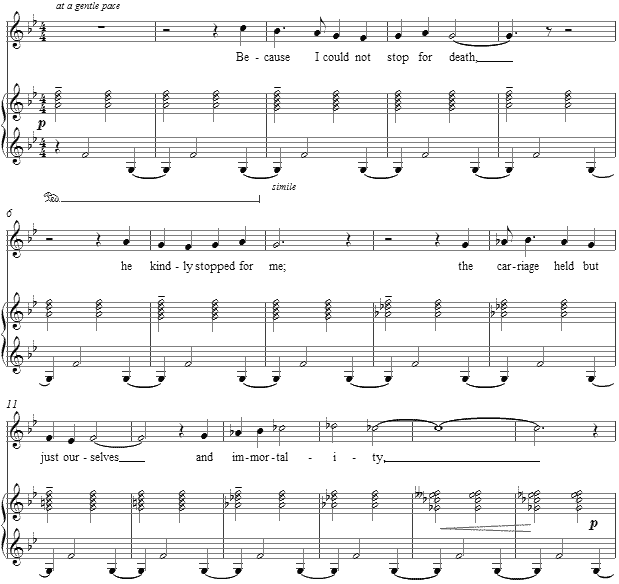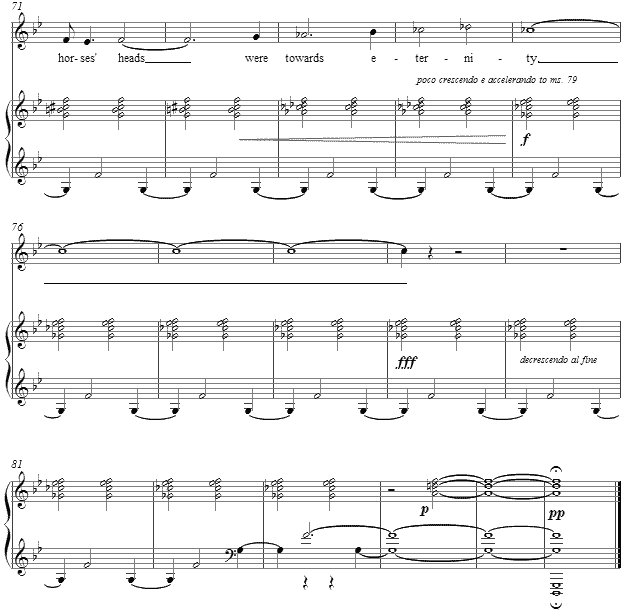Music and Texts of GARY BACHLUND
Vocal Music | Piano | Organ | Chamber Music | Orchestral | Articles and Commentary | Poems and Stories | Miscellany | FAQs
Because I could not stop for death - (1990)
Emily Dickinson
originally for high voice and piano
Because I could not stop for Death,
He kindly stopped for me;
The carriage held but just ourselves
And Immortality.
We slowly drove, he knew no haste,
And I had put away
My labor, and my leisure too,
For his civility.
We passed the school, where children strove
At recess, in the ring;
We passed the fields of gazing grain,
We passed the setting sun.
[ Or rather, be passed us;
The dews grew quivering and chill,
For only gossamer my gown,
My tippet only tulle. ] [ 1 ]
We paused before house that seemed
A swelling of the ground;
The roof was scarcely visible,
The cornice but a mound.
Since then 'tis centuries, and yet each
Feels shorter than the day
I first surmised the horses' heads
Were toward eternity.[ 4 pages, circa 3' 45" ]
Emily Dickinson
Dickinson left several versions of this poem. The punctuations and phrases are however similar, and any reading of the text would be approximately the same, irrespective of which version is considered.
Emily Elizabeth Dickinson (December 10, 1830 – May 15, 1886) was almost unknown and nearly unpublished in her own lifetime. She has since come to be regarded along with Walt Whitman as one of the two great American poets of the 19th century. Often called reclusive, Dickinson lived nearly her whole life at the Dickinson Homestead in Amherst, Massachusetts.
Dickinson's poetry is often recognizable at a glance, and is unlike the work of any other poet. Her facility with ballad and hymn meter, her extensive use of dashes and unconventional capitalization in her manuscripts, and her idiosyncratic vocabulary and imagery combine to create a unique lyric style. Her work was initially published in heavily-edited form, finding popularity in the 1890s. Her poetry was republished in 1955 in a form closer to her manuscripts. It still appears strikingly modern in many respects. Her life, about which little is definitively known, has inspired numerous biographers and voluminous speculation. Dickinson died of what would today be called nephritis, a sometimes acute disease of the kidneys. Her last words were: "I must go in, for the fog is rising."
By the time of her death, only ten of Dickinson's poems (which number almost 1800) had been published. Three posthumous collections in the 1890s established her as a powerful eccentric, but it wasn't until the twentieth century that she was truly appreciated as one of the greatest American poets.
The setting is a simple rocking motion between lines, insistent and steady, over which the voice declares this fatal text. The piano accompaniment should blur the gestures. (The examples below are drawn from the medium key edition.)
The intensity and drama of the piece rises to the line realizing that the "house" was the grave whose "roof was scarcely visible, the cornice but a mound." The accompaniment begins anew in the same methodic pattern, and the setting concludes simply by fading away. As the setting is simple, the singing of it must be as well, drawing an interpretation from the rise in intensity of the setting. It is most assuredly not a horrific tale in either text or music, but rather a realization of "eternity."
The score is available as a free PDF download, though any major commercial performance or recording of the work is prohibited without prior arrangement with the composer. Click on the graphic below for this piano-vocal score.
Because I could not stop for death
NOTE
[ 1 ] This stanza of the poem is omitted in the setting, simply as the advance of the drama carried by the chords successions suggested moving forward to the stanza thereafter.


